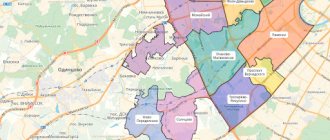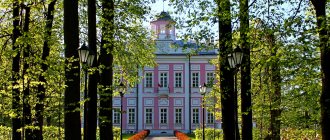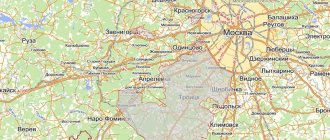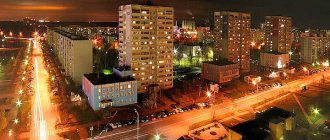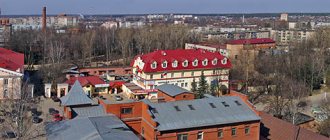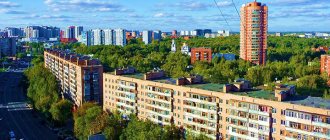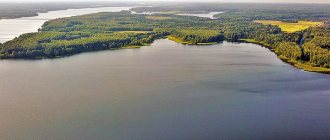Troitsk is located 18 kilometers from the Moscow Ring Road along the Kaluga Highway. This distance to Moscow can be covered by personal transport or by bus (minibus) going to the Teply Stan metro station; there is no railway in Troitsk.
The city itself has an interesting history. In 1627, the chronicle mentions Trinity Heath, which became a village 20 years later thanks to the construction of the Trinity Church. The village residents were engaged in weaving; it is not surprising that a woolen factory was founded here, which became one of the most advanced in Russia at that time.
History of Troitsk
Troitsk was founded on June 19, 1743 by the governor of the Orenburg region I.I. Neplyuev as a fortress on the Uysk border line to protect the lands from raids by nomads. The name was given after the church holiday Trinity. It so happened that I.I. Neplyuev stopped at this place on Trinity Sunday.
The main caravan route from Asia to Europe passed through Troitsk. Opposite the fortress on the right bank of the Uy River, an exchange yard was built, which existed until 1915, as well as a border customs office.
During the Peasant War, in May 1774, the fortress fell as a result of an assault by the troops of Emelyan Pugachev. However, the very next day the fortress was liberated by state troops. There were some bloodsheds here during the Civil War.
In 1784, by decree of Catherine II, Troitsk received city status. It is known that at the end of the 19th century, 14 thousand inhabitants lived in the city, there were 1,446 residential buildings (of which 55 were made of stone), 253 trading shops and 34 enterprises operated: tanneries, flour mills, lard making, brewing, soap making, candle making, glue making and others. There were 8 Orthodox churches, 4 mosques and a synagogue in Troitsk. From 1750, from May to October, the city hosted a fair, which gradually became one of the largest in the country. In 1842, a terrible fire broke out in Troitsk. The fire destroyed about 300 houses. Gradually, the fire victims rebuilt.
The city was rich. As a legacy from bygone times, treasures are found from time to time in old houses. Thus, one of the recent treasures was found in a house on Letyagina Street during renovation in the fall of 2022. Under one of the boards in the floor lay a large sum of money and furs, wrapped in newspaper. And in 2013, also while renovating a house, another local resident found a glass bottle with paper money from 1909 in a pipe. Even earlier, in a mosque on Lenin Street, under the stairs, a bundle with royal money was found, there were more than 22 thousand rubles.
Interesting, even older finds were also made near Troitsk. Thus, in the Historical Museum of the Southern Urals in Chelyabinsk you can see a stone sacrificial bowl in the form of a ram’s head. And back in the 19th century, a copper Buddhist idol with silver inlays on the front side, found near Troitsk during the mining of gold-bearing sands around 1854, was transferred to the UOLE Museum (now the Sverdlovsk Regional Museum of Local Lore).
The 19th century was the heyday of Trinity. It turned into a trade and cultural center of the Southern Urals. There were also schools, colleges, madrassas, and a library. On July 21, 1891, Tsarevich Nikolai Alexandrovich (future Emperor Nicholas II) visited Troitsk. He stopped to rest in the house of the merchant G.F. Zarubina (Klimova St., 16), which has survived to this day.
Nowadays, the city-forming enterprise is the Troitskaya State District Power Plant, the construction of which began in 1954. There is also an electromechanical plant and a mineral plate plant. The population of Troitsk is currently 75 thousand people.
According to local historians, it was in Troitsk (and not in Moscow) that the famous fabulist Ivan Andreevich Krylov was born. Documents about Krylov’s birth have not been preserved, but it is known that Krylov’s father, Lieutenant Andrei Prokhorovich, lived with his wife in Troitsk from 1765 to 1769. It’s paradoxical, but in the city there is neither a street named after Krylov, nor a monument, nor a memorial plaque.
Troitsk is the birthplace of the famous lawyer Fyodor Plevako, Soviet poet Boris Ruchev, and film director Vera Storozheva. The Bashkir poet and writer Mazhit Gafuri, the Tatar poet and public figure Gabdulla Tukai, the founder of meteorology in the USSR and researcher of the Tunguska meteorite Leonid Kulik lived in Troitsk for some time.
Temple of Dmitry of Thessalonica, monument to the founder of the city and memorial steles
On the same street there is the Church of Demetrius of Thessaloniki. It was erected in 1873, and in 1889 a stone bell tower was added to the church. The temple is designed in a classical style, with Baroque elements. During the Soviet era, the church was closed for several years, but in 1947 it was returned to believers.
Monument to the founder of the city
In the park in front of the temple there is a monument to the founder of the city, Ivan Ivanovich Neplyuev. It was installed there in 2001. In addition, the church also contains memorial steles: to the first builders of Trinity, the Trinity Fair and the Christian holiday of Trinity.
Address: st. Gagarina, 7a.
Sights of Troitsk
There are more than 70 historical and cultural monuments in Troitsk, 5 of them are of federal significance. No wonder Troitsk is called an open-air museum.
The first iconic landmark of the city that you encounter upon entering it is the water tower . It stands at the beginning of Gagarin Street at the entrance to the central part of the city. It was built already in Soviet times - in 1927. The tower was erected in the style of early postmodernism according to the design of the architect V. Sanzharevsky. It has an openwork octagonal design in the Gothic style. It is an architectural monument.
On the same street there is the Church of Dmitry Solunsky (Gagarin St., 7a). It was built in 1873, and in 1889 a stone bell tower was added. Built in a classical style with baroque elements. During Soviet times it was closed, but already in 1947 it was returned to believers. Researcher V.I. Yurin writes that under the church (in the basement under the ceiling) there is an underground passage-air duct of a rectangular shape. It served to heat the building.
But what is more interesting here is not so much the church as the square in front of it. In the center of the square there is a monument to the founder of the city, Ivan Ivanovich Neplyuev (1693-1773). It appeared in 2001, created according to the design of sculptor Vladimir Zharikov.
Also in the park there are steles dedicated to the First Builders of Trinity, the Trinity Fair and the holiday of the Trinity .
Nearby is the Kazan-Bogoroditsky convent with the Church of the Transfiguration of the Savior from the mid-19th century, and on the other side is the park of culture and recreation named after. Tomina .
Then you can get to the Holy Trinity (Uysky) Cathedral (Krasnogvardeyskaya St., 1). In the past, this is where the Trinity Fortress stood, from which the city began. This church is the first stone building of Trinity. It was founded in 1754 with the participation of Governor General I.I. Neplyueva. Construction was completed in 1761. Subsequently, the church suffered from attacks by the Pugachevites and fires; it was rebuilt several times. In Soviet times, in different years there was a raw leather warehouse, a construction office, a dormitory, a laundry, a boiler room, and a gym located here. Now the church is active. In 2001, on the glass of the icon of St. Nicholas the Wonderworker, believers noticed a print with the image of the saint, which they took for a miracle. This icon can be seen here today. The building has the status of a cultural heritage site of federal significance.
In the park near the Holy Trinity Cathedral, a memorial stone in honor of the founding of the Trinity Fortress. Nearby, in November 2022, representatives of the Armenian diaspora erected a khachkar cross , reminiscent of the Armenian genocide. Interestingly, it is made by hand from tuff mined in the vicinity of the Ararat Valley. There is a bridge across the Uy River nearby.
On the street Klimova, 5a, the buildings of the Trading Rows . They were built in 1866-68 on the central square of the city at the expense of merchants Yaushev, Pupyshev, Osipov, Bakirov, Zarubin and others. They included a façade and two wings on the south side of the main city square. During Soviet times, the premises were used as warehouses. Nowadays, part of the building was transferred to the Trinity branch of Chelyabinsk State University (CSU). The shopping arcades have the status of a cultural heritage site of federal significance.
Nearby, in old buildings of the 19th century, the Trinity branch of ChelSU is located (Oktyabrskaya St., 79). In the past, shops and warehouses were located on the ground floor, and the second floor was rented by the city council. In summer there are fountains nearby.
A monument to the famous lawyer F.N. was erected nearby in 2013. Plevako - a native of Troitsk.
There is also a monument to V.I. Lenin , opened on November 7, 1924. Before the revolution, a bust of Emperor Alexander II stood on this marble pedestal.
In the past, Central Square was called Mikhailovskaya - St. Michael's Cathedral stood on it, demolished in 1967. On the Central Square there is the city administration building (Klimova St., 7). The house, built in 1873, was previously occupied by a fire station.
In 1892-94, the building was rebuilt and transferred to the District Court. Lawyer Fyodor Plevako also spoke here a couple of times. The memorial plaque reminds us of this.
And across the road, in the former building of the Siberian Bank 1893-1903. buildings, houses the Trinity Museum of Local Lore (Lenin St., 70, tel. (35163) 2-12-52). Here you can get acquainted with the history of the city.
Also famous among the museums of Troitsk is the Anatomical Museum, located on the territory of the Ural State Academy of Veterinary Medicine (Gagarina St., 13). It has 2 thousand natural preparations. Here you can see stuffed animals, skeletons of rare animals, archaeological finds, preparations of animal and human organs. It is sometimes called one of the best anatomical museums in the country.
But let's return to Central Square. Across the street from the museum and from the city administration is the building of the Main Post Office (Lenin St., 69). The post office is located in the former mansion of the merchant Osipov, which was later transferred to the customs department. When the Troitsk customs house was abolished in 1868, the city government moved here.
Behind the city administration building is the most beautiful building in Troitsk - the Bashkirov Hotel (Klimova St., 9). The building was built in Art Nouveau style in 1908 by merchant Gavriil Alekseevich Bashkirov. It is decorated with a colonnade, rich stucco and multi-colored stained glass windows. The building was restored in 2011. It is an architectural monument of federal significance.
According to legend, while at the Nizhny Novgorod fair and heavily drunk, Bashkirov made a bet with three local merchants who did not believe him that in Troitsk there was a magnificent stock exchange hotel with a first-class restaurant. In fact, at that time Troitsk had only inns and furnished rooms. But a bet is a bet, and once he gave his word, Bashkirov invested a significant part of his fortune in the construction of a luxury hotel. Just a year later, at the opening of the next Trinity fair, a building in the Russian Art Nouveau style designed by the architect Fedorov appeared before the amazed merchants. According to another legend, at least a kilogram of silver and gold coins was laid under the foundation of the building.
Surprisingly, only the main facade of the building looks beautiful. From the end there is an ordinary brick plane.
On the street Brothers Malyshev, 32 there is another beautiful building - Yaushev Passage . It was built by order of the Yakushev merchants in 1911. In pre-revolutionary Russia, large, expensive stores were called passages. Like the Bashkirov Hotel, this building was built by the architect Fedorov. Since the area here was swampy, larch piles and a lead cushion were used for the foundation. A drainage system was also used. The passage was equipped with telephone communication, an elevator and electric lighting. Alas, this building is not in use and is gradually being destroyed. Nearby there is a memory square with the Oath memorial.
Also in Troitsk, an ordinary-looking wooden house in which L.A. Kulik (Volodarsky St., 26).
To be fair, it is worth noting that not everything in Troitsk is ideal. There are many abandoned, dilapidated beautiful mansions, and garbage is often found on the streets.
In Soviet times, a reservoir , so the Uy and Uvelka rivers within the city are quite wide. The power plant's pipes are visible from afar.
On the right bank of the Uy River there is an interesting natural attraction of the city - Pugachev Cave . It's not big. According to measurements by V.I. Yurina, 19 m long. It is located in a remnant 25 m high, at a height of 8 m above the water. It has two entrances, the vaults are heavily smoked. Researcher V.I. Yurin writes that this is the longest cavity in serpentinite rocks in the Chelyabinsk region. It is pseudokarst, of gravitational-tectonic origin. Since 1969, the cave has been a geological and geomorphological natural monument of the Chelyabinsk region.
According to legend, during the siege of the Trinity Fortress, Emelyan Pugachev’s tent stood here, and from here the head of the rebels watched the capture of the fortress. According to another legend, Pugachev allegedly rested in this cave after being wounded in the arm, received the day before as a result of an unsuccessful assassination attempt. There is also a traditional legend that another Pugachev treasure is hidden here.
The city of Troitsk is located in a steppe area, so the few forests found here are valued. The botanical natural monument Park “Steppe Dawns” is located on the right bank of the Uvelka River on the western outskirts of the city. This park was laid out back in the 1880s with several alleys around the summer cottages of the Trinity merchants Urazaev, Volkov and Nanbaev. Balsam poplar, Scots pine and Siberian larch were planted here. In 1919, a kumiss clinic for pulmonary patients was organized on the basis of the estate, and later a bone-tuberculosis sanatorium was created here. The species composition of the park's plantings was enriched in the post-war years. To this day, plantings of trees over 100 years old have been preserved in several places. Alas, in the 1970s, almost all Scots pine died due to drought.
Even more valuable is the “Golden Sopka” pine forest on the left bank of the Uy River, also declared a natural monument of the Chelyabinsk region. This island pine forest is a relict of the Pleistocene periglacial forest-steppe and is of great importance.
It is worth noting that the city of Troitsk is also attractive due to its abundance of sun. In terms of the average annual number of sunny days (2218 hours/year), it is even ahead of Sochi! It is considered the sunniest city in the Urals and one of the sunniest in Russia.
And one more interesting fact: Chelyabinsk Troitsk is often confused with Moscow. When, preparing for a trip to Troitsk, I booked accommodation there with a local resident, she asked if it was Troitsk that I was calling. He says that Muscovites often call by mistake.
Water tower
The first iconic landmark of the city, which is found right at the entrance to its central part, is the water tower, built in the style of early postmodernism.
Water tower
It seems that this octagonal structure in the Gothic style was erected somewhere in the Middle Ages. However, it was built in Soviet times - in 1927, according to the design of the architect V. Sanzharevsky. The tower is deservedly recognized as an architectural monument.
Address: st. Gagarin.
How to get to Troitsk?
The city of Troitsk is located in the Chelyabinsk region, 125 km south of Chelyabinsk. You can get to it along the Trinity Highway from Chelyabinsk.
The Chelyabinsk-Orsk railway passes through the city. By public transport you can get here by bus from Yekaterinburg or Chelyabinsk, or by train from Chelyabinsk.
Pavel Raspopov
Sources: Andreev Alexey. Guide to the most remarkable places of TroitskWikipedia Specially protected natural areas of the Chelyabinsk region Rundkvist N.A., Zadorina O.V. Ural: Illustrated encyclopedia of local history. - Yekaterinburg, 2013. The frontal place of history // Chelyabinsk worker, 10.22.1998. Yurin V.I. Caves of the Chelyabinsk region: history of discoveries and research results. 2011-2020. – Chelyabinsk, 2022.
Kazan-Bogoroditsky convent with the Church of the Transfiguration
The Kazan-Bogoroditsky convent was founded in 1851, but was closed during the years of atheism (in the 1920s). One of the monastery churches - Kazan - was dismantled into bricks. The Church of the Transfiguration of the Lord (built in 1870) has been preserved. He is active.
Of the pre-revolutionary buildings of the monastery, the building of the Nikolaev school for girls, built in 1896, as well as the building of the hotel for pilgrims, have also survived to this day.
Kazan-Bogoroditsky convent with the Church of the Transfiguration
The Holy Kazan Convent was revived in the 1990s, through the efforts of Mother Ksenia Kadomtseva. The monastery is open for visits and excursions every day.
Address: st. Gagarina, 1/10.
Temple of Alexander Nevsky
In the second half of the 19th century, on Trinity Zarechnaya Sloboda, people built a church in honor of St. Prince Alexander Nevsky. Construction dates back to 1884-1889 from foundation to consecration.
Temple of Alexander Nevsky
Like most other churches, this church was closed by the Soviet authorities. But not destroyed. The date of its revival coincides with the date of the fall of the USSR - 1991.
Address: Shosseynaya street.
Shopping arcades and a complex of ancient buildings of the local branch of ChelSU
On Klimov Street the buildings of the ancient Trading Rows have been preserved. They were built in the 19th century, and in Soviet times were used as warehouses. Nowadays, part of the building was transferred to the Trinity branch of Chelyabinsk State University (CSU). The shopping arcades have the status of a cultural heritage site of federal significance.
Complex of ancient buildings of the local branch of ChelSU
Nearby, in old buildings, also built in the 19th century, the Trinity Branch of ChelSU is located (Oktyabrskaya St., 79). In the summer, beautiful fountains operate next to them.
Ecology
A peculiarity of the construction and development of the city was that the initially existing separately working village and scientific town developed towards each other, then microdistrict “B” was built next to the factory village.
Therefore, a large area of forest has been preserved in the city center and turned into a park. During the construction of new industries and residential buildings, forest areas were also protected whenever possible. So the residents are guaranteed fresh air - unless those very beautiful forests are cut down for private commercial interests or urban infrastructure needs.
Stele at the entrance to the city
Drinking water in Troitsk is of low quality - local residents (especially microdistrict B) often complain about rust and sand impurities.
The forest is in poor condition: a lot of fallen trees and debris. There are packs of stray dogs.
Monument to Ivan Andreevich Krylov
In the city of Troitsk in 2022, a sculptural group was installed dedicated to the famous native of the city - the great Russian fabulist I.A. Krylov and the heroes of his fables.
The statues were made by masters of the Kasli plant, famous for artistic cast iron casting. Kasli sculptor, member of the Union of Artists of Russia Natalya Kulikova worked on the images.
Monument to Ivan Andreevich Krylov
The main figure is the fabulist himself, who sits on a bench and watches the characters in his fable “The Crow and the Fox.” A crow with cheese in its beak sits on the back of a bench, and on the ground in front of it sits a fox with its paws pressed to its chest. In addition, it was decided to depict the characters from the fables “Quartet” and “The Monkey and the Glasses” in the casting.
Location: Klimova street.
Church of Elijah the Prophet
This Orthodox church with its characteristic rounded dome is the only example of neo-Byzantine style architecture in the city of Troitsk. The Church of Elijah the Prophet was built in 1895 and operated at the local prison. The sponsor of the construction, the merchant Kormiltsev, wanted the prisoners to have the opportunity to fully perform all religious rituals and celebrate Orthodox holidays.
Church of Elijah the Prophet
Both the prison church and the prison itself were closed with the establishment of Soviet power. At the same time, the prison was dismantled for building materials, but the Church of Elijah the Prophet was left. In 1998, its restoration began, and in the early 2000s the temple became operational again.
Address: st. Denisova, 3b.
Memory Square. Memorial "Oath" and Alley of Heroes
In the 1970s, a military memorial dedicated to all participants in the Great Patriotic War was erected in the central city square. This memorial is called “The Oath”. Its central figure is a statue of a Soviet soldier, bending one knee and swearing to avenge his comrades.
Memory Square. Memorial "Oath" and Alley of Heroes
Next to the “Oath” memorial, also on the territory of the Memory Square, there are seven busts of natives of the city and the surrounding area who fought on the fronts of the Great Patriotic War and were awarded the high title of Heroes of the Soviet Union. This part of the park was called the Alley of Heroes.
Address: corner of Malyshev Brothers and Gagarin streets.
Dialogue that didn't exist
“There were, of course, public hearings,” recalls Alexander Litoy. - This is complete trash and waste. Because the halls were, as luck would have it, the smallest and filled to capacity with unfortunate state employees, housing office workers and veterans of the Ministry of Internal Affairs. It is impossible to get in from the outside. I settled in with some gloomy veterans of something powerful and walked with them. But there were an obvious minority of “living” people there.
Historical reference
The city has a history dating back to the 17th century. Troitsk inherited its name from the ancient village of Troitsky, located on the site of the northern part of the modern city. Troitskoye was adjacent to the settlements of Butakovo (Batakovo/Botakovo) and Bogorodskoye. These names still exist on the territory of modern Troitsk.
In the scribe book of 1627 there is the first mention of the Troitskaya wasteland
as the ancient estate of boyar I. I. Saltykov.
[3] It is the wasteland
, and not
the village/village
, and what this means can only be guessed. For a long time, the year of the Trinity’s birth was taken “on faith” from the book of the historians Kholmogorovs (see link above), although it was not quoted by them, but came from them as the authors [4] (apparently, this was the year of dating of the scribe’s book itself). In 2009, information appeared that the village of Butakovo (and the Troitskaya wasteland was with it) had an earlier mention in the chronicles - 1622. [5] In 2012, Troitsk researchers got directly to the document on which the Kholmogorovs relied. A careful reading and deciphering of the text of the scribe’s book allows us to assert that “the village of Butakovo with the Troitskaya wasteland was granted to Ivan Saltykov by the sovereign in 7125 (1617).” Thus, it is 1617 that can be taken as the beginning of the Trinity history. [6]
In 1700, L. I. Saltykov gave the village of Troitskoye with the neighboring village of Butakovo to his daughter and her husband, Prince P. G. Shcherbatov.
In 1751, the owner of the village, Ya. M. Evreinov, began to build a linen enterprise in the village, on the basis of which, presumably, a factory later arose.
Park of Culture and Leisure named after. N.D. Tomina
The main park of culture and recreation in Troitsk is named after Nikolai Dmitrievich Tomin, a Red military leader, a hero of the Civil War, who in 1918 commanded the Troitsk detachment of Red Guards.
The park on this territory appeared before the revolution - in 1908. During the Soviet years, it repeatedly strengthened its reputation as the best vacation spot in Troitsk. It is not for nothing that the park is very popular. This is due to its walking distance and well-developed infrastructure for spending time with family and children.
The park has a whole range of attractions, sports and playgrounds. There are two Ferris wheels - a larger one and a smaller one. There is also a small artificial pond, and rental of children's boats for water trips is organized.
Park of Culture and Leisure named after. N.D. Tomina
In winter, this park has a skating rink where the whole family can skate to positive music. They also build slides for skiing, made of snow and ice.
In the park named after Tomin, festive events are regularly held on calendar holidays - New Year, Christmas, Maslenitsa and Victory Day. City Day in Troitsk is celebrated in the summer, together with Russia Day and on the eve of the Trinity Day. These days, it has become a tradition to organize a special program: representatives of different national cultures pitch their tents, offer national dishes and folk songs. Since 2009, a rock festival in memory of Viktor Tsoi has been held every year in the park.
The central entrance to the park is located on Sovetskaya Street.
Address: st. In honor of the 30th anniversary of the Komsomol.
To be fair, it should be noted that not all historical and architectural monuments in Troitsk look decent. The city also has a lot of abandoned, dilapidated buildings, and on the streets you can often find unkemptness and disorder. But there are fewer and fewer shabby, depressing-looking places every year.
Trinity Museum of Local Lore
This municipal cultural institution is the first museum in the city dedicated to its history and culture.
It was created on August 13, 1925. Over the hundred-year history of its existence, the Trinity Museum of Local Lore has accumulated rich art and archaeological collections, collections of numismatics, household items and documentary sources - in total, over forty thousand items.
Trinity Museum of Local Lore
The exhibition presents interesting sections of archeology, the history of the Trinity Fortress, fair trade, merchant life; rich collection of paintings; books of the 17th-18th centuries. In 2022, the museum's new exhibition hall opened after major renovation and reconstruction.
Since 2022, the Trinity Museum of Local Lore, together with the local historical reconstruction club “Beaver Rush,” annually holds the “Southern Frontier” historical reconstruction festival. It is dedicated to medieval themes.
Address: st. Lenina, 70.
Real estate
Supply structure by type of house in Troitsk as of mid-July 2016
| House type | Offer structure,% | Average unit supply price, thousand rubles/sq.m |
| Brick with large kitchen | 7 | 112.4 |
| Brick with small kitchen | 1 | 105.9 |
| Monolith, monolith-brick | 35 | 108.1 |
| Panel with small kitchen | 18 | 111.0 |
| Typical panel | 15 | 111.5 |
| Improved panel | 14 | 113.8 |
| "Khrushchev" | 10 | 103.6 |
According to the research department of MIEL-Network of Real Estate Offices
Children's playgrounds in Troitsk are no different from those in Moscow
Housing prices in microdistrict A are among the most affordable. A one-room apartment can be bought for an average of 3 million rubles, a two-room apartment for an average of 4 million rubles, and a three-room apartment for an average of 5 million rubles.
The housing stock of microdistrict B is represented by houses built in the 70s (these are usually high-rise buildings with 9-12 floors) and houses built in the 80s-90s (16-story buildings). Housing prices here are slightly higher. On average, a one-room apartment can be purchased for 4 million rubles, a two-room apartment for 4.7 million rubles, and a three-room apartment for an average of 6.7 million rubles.
In microdistrict B there is, so to speak, the local Arbat - Sirenevy Boulevard, the main walking place for local residents and a square with a fountain and a summer amphitheater, where all the main folk festivities take place. The street of traffic police colonel Kurochkin is also located here - one of three in Troitsk, the name of which is not associated with scientists.
Most of the streets in Troitsk are named after scientists. Kurochkina Street - in honor of the traffic police colonel
This was once the village of Fabrichny, which later became part of the city. The houses on Akademicheskaya Square are among the most expensive in the city (monolith, monolith-brick, as well as panel houses built to resemble brick ones). They form a kind of enclave. A significant advantage of microdistrict B is that the terminal stations of bus routes that go to the Salaryevo and Teply Stan metro stations are located here.
In terms of infrastructure, it is worth noting the central market, the sports palace and the central children's art school, where it was announced that the Novomoskovsky and Troitsky districts would join Moscow. You can buy a one-room apartment here for an average of 5 million rubles, a two-room apartment for an average of 7 million, and a three-room apartment for an average of 9 million rubles.
The Solnechny microdistrict is adjacent to the A microdistrict. It is also called the “Solar Triangle”, as it is enclosed in a kind of triangle formed by the streets of Academician Cherenkov, Fizicheskaya and Troitsky Boulevard. It is built up with modern houses up to 6 floors high in a single architectural style. Some houses even have underground parking.
A new low-rise residential microdistrict is planned to be built in the north of Troitsk, on the site of the former garden plots of SNT “Veteran-1”. True, the issue of transport accessibility is unclear, because... st. Textile workers, where it will be located, is clearly not designed for the new flow of vehicles. In addition, we should not forget about the problems with kindergartens, schools and other social infrastructure of the city.
SNT "Veteran-2" faces an even sadder fate: the garden plots of WWII veterans with buildings are expected to be seized for the construction of a 4-6 lane highway.
Not far from Akademicheskaya Square there is the Sosny residential complex, which, in fact, is also separated into a separate microdistrict. This is a cottage community, with all central communications. By the way, a similar decision awaits him: the very pine grove after which the microdistrict is named will be cut down, and the playgrounds will be demolished. There will also be a road here.
Residents claim that its function is mainly transit: trucks wanting to get from Kaluzhskoye to Kievskoye Highway will pass right here, so the residents themselves, of course, are against such urban planning decisions.
In July 2016, there was a total of 20.4 thousand square meters on the primary and secondary housing market in Troitsk. m. of housing, reports the Department of Consulting and Analytics. The share of the primary market accounted for 54.9% of the total supply. The share of secondary housing was 45.1% of the total volume of apartments on sale.
More than 140 apartments were exhibited on the primary market in July, the total area of which was 11.2 thousand square meters. m. (consisting of 3 projects, 9 buildings). Currently, the supply volume of the Troitsk primary market is approximately 2.9% of the total volume of the primary market of New Moscow. According to the structure of demand, 92.5% of the total supply falls on comfort class and 7.5% on business class. There are no economy class projects. The weighted average price of the primary market is 87.6 thousand rubles/sq.m. m.
Since there has been no new supply in the annexed territories for quite some time, the number of projects remains virtually unchanged. This also explains the rather high stage of readiness of many buildings.
For example, the residential complexes Solnechny and Izumrudny have already been put into operation, and landscaping is underway in Troitskaya Riviera. Installation and finishing work is underway in three buildings of the Legend residential complex, and only one building of this project is at the initial stage of construction.
| LCD | Readiness | Apartments for sale | Footage min, sq.m | Meterage max, sq.m | Average price sq.m. | Cost min | Cost max |
| Legend, building 1 | Installation and finishing works | 18 | 41.2 | 88.6 | 82026 | 2.7 million | 7.5 million |
| Legend, building 2 | Installation and finishing works | 11 | 37.1 | 71.6 | 86162 | 2.7 million | 7.3 million |
| Legend, building 3 | Installation and finishing works | 63 | 38.4 | 89.9 | 80332 | 2.7 million | 7.5 million |
| Legend, building 7 | Start of construction | 22 | 46.8 | 84.9 | 83536 | 3.3 million | 7.3 million |
| Trinity Riviera (New Quarters) | Landscaping, civil works in progress | 8 | 76 | 108 | 93100 | 7.08 million | 8.7 million |
| Villa Riva | Interior work | 20 | 79 | 170 | 120000 | 7.11 million | 20.4 million |
| Emerald | Commissioned | 4 | 76.8 | 94.5 | 85286 | 6.5 million | 7.5 million |
| Solar building 10 | Commissioned | 4 | 60.3 | 127.2 | 107350 | 6.6 million | 13.5 million |
| Solar building 11 | Commissioned | 5 | 69.2 | 118.93 | 108200 | 7.6 million | 12.9 million |
The most inexpensive offer is a 20-meter free space “for a studio apartment” on the 1st floor of a 3-story building on the street. Park street with cosmetic repairs. It is assumed that the premises can be converted into residential. The cost is 836,000 rubles, 41,800 rubles per sq.m.
In general, an interesting trend is now emerging in New Moscow. The authorities oblige developers to build commercial space; without this, the project is not accepted or approved.
But the mere presence of retail or office space does not develop business activity. As a result, it becomes easier for the developer to sell the “vacant premises” to someone who will turn it into residential apartments.
By the way, we must not forget that utility tariffs in New Moscow are on average 10% lower than in the old one.
Shopping arcade of the Yaushev brothers
Representatives of the Yaushev merchant family owned trading houses in many cities of the country. At the turn of the 19th and 20th centuries, their business empire began to operate in Troitsk.
Despite the fact that they got the site for the construction of the passage on a wetland, by 1911 a magnificent building designed by Arkady Fedorov had risen on it. Its architecture organically combines three styles: neoclassicism, renaissance and baroque. At the time of its appearance, this building was very progressive and technologically advanced in terms of technical solutions and equipment. For its construction, a special drainage system was used. And the foundation was mounted on larch piles and a lead cushion.
Shopping arcade of the Yaushev brothers
The passage was initially full of all the technical innovations of that time: telephone communications, elevators, electric lighting. In the regional center of Chelyabinsk there is a “sibling” of the Trinity Passage, which is occupied by the Chelyabinsk Museum of Art.
Address: st. named after the Malyshev Brothers, 32.
Anatomical Museum
Far beyond the city of Troitsk, the Anatomical Museum is known, which is located on the territory of the Ural State Academy of Veterinary Medicine, on Gagarin Street, 13. It has two thousand natural exhibits.
At its exhibitions you can see stuffed animals and skeletons of rare animals, archaeological finds, and individual dissected organs of animals and humans. Thanks to its rich collection, this institution is rightfully considered one of the best anatomical museums in our country.
Address: st. Gagarina, 13.
Holy Trinity Cathedral
This church is the first stone building in the city of Troitsk. It was founded in 1754 and completed in 1761. The Trinity Fortress was located on this site, which gave rise to the city.
Holy Trinity Cathedral
During Soviet times, the temple was closed (finally in 1940), and its building in different years was used as a warehouse for raw hides, a construction office, a dormitory, a laundry, a boiler room, and a gym. In 1997, the church was returned to the believers. The building of the Holy Trinity Cathedral has the status of a cultural heritage site of federal significance.
Address: st. Krasnogvardeyskaya, 1.

